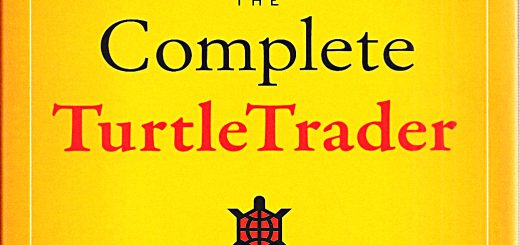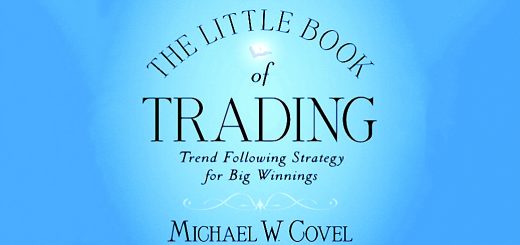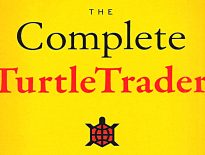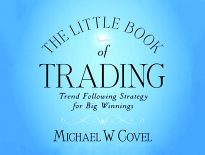The Little Book of Trading – Part 3

Today’s post is our third visit to one of the “Little Books” – Michael Covel’s Little Book of Trading.
Contents
Throw Away the Fundamentals – Bernard Drury
Michael holds up Bernard Drury as:
A great example of a trader who, early in his career, followed stories, then came to realise that trend following was a more direct path. He let go of fundamentals.
Drury’s trading career began in 1978, and he spent the next 15 years as a grain trader, eventually for his own account.
- He was trading on fundamentals – supply and demand.
He saw traders around him who were 10, 15, and 20 years older. These were successful, wealthy, and prominent speculators and they were all using fundamentals to make money.
Michael is sceptical:
Does that sound like something you could do? If you think you could, how long would it take you to assemble all of that expertise? How many years of your life would go by?
And even if you were smart and studious enough, would having all of the expertise to translate fundamentals allow you to know the right time to buy or sell in the markets to make money in the long run?
Lots and lots of data, but no guarantee that fundamental analysis would actually make money.
Drury changed his mind when he did an MBA at the University of Chicago and took a class on decision-making under uncertainty.
The studies with Professor Hogarth increased my curiosity about the ways in which models, or expert systems, could be applied to situations such as trading.
Michael also points out that becoming an expert on the fundamentals of a single market doesn’t help with diversification.
Drury joined Commodities Corporation (CCV) – by then, a trend-following trading firm.
Commodities Corporation started as a fundamentally driven trading firm too, but eventually they came to realize that trend following trading was the real breadwinner.
CC launched the careers of many notable traders – such as Michael Marcus, Bruce Kovner, Ed Seykota, and Paul Tudor Jones. Goldman Sachs bought CC in 1997.
Many of those names will be familiar from our articles on the Market Wizards series of books.
Drury says:
I adopted a systematic approach in which the most important benefits are the application of very extensive research, consistency of method, and diversification.
If we are curious about a trading rule, we run a simulation across a portfolio of about 70 instruments and 15 years of data.
Michael says:
What if a commodity goes up half the amount that fundamentals might permit?The risk-reward has shifted greatly. A prudent [fundamental] trader might reasonably exit or lighten up based on these shifted odds.
A fundamental trader might call the beginning of a trend right, when he perceives a value opportunity, but will often have difficulty taking advantage of pronounced trends.
The fundamental trader is actually taking on risk by giving up on the potential big trends. By trying to be so risk averse, the fundamental trader actually is taking on more risk.
Here are some of Drury’s principles:
- Position size is always calculated from the daily account value.
- So the size of your new positions will decline when your account value drops.
- Decide to be in or out of each market.
- Drury trades 30 markets, aiming to be in each market about two-thirds of the time, and out of the market about one-third of the time.
- Over multi-year periods when a market or group of markets does well for a time, it will be followed by poor results for a time.
- But there is no way to predict trends.
- Calculate risk prior to entry.
- Position size needs to reflect the volatility of the market at the time of your entry.
- A portfolio should be broadly diversified.
- That means half in financial markets (interest rates, currencies, and stocks) and half in physical commodities.
- Enter into incipient trends
- Exit when trends fail, and remain with winning trends for long periods.
Drury’s strategy made 75.65 percent during the crisis year of 2008.
When the next crisis time happens, trend trading will produce huge opportunities. That is a much better option than just buying gold.
Study Hard and Get an A – Justin Vandergrift
There is only one factor that you can control when you start trading: how much you are willing to lose. That is the essence of risk management.
Vandergrift spent his teen years drawing market charts on grid paper (before computer charting). He took odd jobs to save money to trade sugar through his dad’s account.
During college at the University of North Carolina, Vandergrift read a lot of trading books and used the TradeStation software to test trend following rules and test system ideas.
After college he went to work for John Hill at Futures Truth Company.
- This is a firm that independently evaluated and ranked trading systems.
So Vandergrift got to see which trading systems that worked and which ones didn’t.
- Most systems failed for a lack of risk control.
Vandergrift found that the only systems that really worked over time were long term trend following in nature.
However, his real Aha! moment came when he put money management into his trading system equation.
For Vandergrift, risk management centered on trading markets equally, from a risk perspective.
You want to risk an equal amount on every trade.
At this point, Michael offers a classification of trend-following systems:
- high/ low breakouts
- single and multiple moving average crossovers
- Bollinger Band breakouts
- the defaults here are 20 days of data and two standard deviations (95% probability)
Don’t get too excited about when to enter. Entry and exit is an overwhelming focus for new traders, but it’s a small part of the winning recipe.
Money management is far more important. What is the most common mistake?
You put a trade on, it starts losing money, but your gut tells you to hang on because it’s going to work out. You end up holding on too long to a losing trade.
Michael asked Vanderbilt about his goals:
If I die tomorrow are people going to remember me because my standard deviation of average annual return was XYZ in relation to my compound of average annual growth rate?
No. They will remember me because of the wealth that my trading created. That is the whole motivation for me.
Vandergrift has little time for index investing:
The S&P is an average, of the 500 largest companies in the United States. It’s a C index [in terms of college grades]. Why would you want to invest to get average returns?
Michael closes the chapter with a piece on compounding:
You want to know the difference between being rich and poor in life? Three percentage points. Twelve percent compounded over 30 years turns every dollar invested into $35.94.
If you compound at 15%, every dollar would be worth $87.54 – 143% more. You have to shoot for the higher return. Even 2% pa more is a huge difference.
You Can’t Know Everything – Eric Crittenden and Cole Wilcox
Eric Crittenden and Cole Wilcox noticed there were no public firms applying trend following to individual stocks and they could not figure out why.
So they tried it.
- Their basic plan was to buy breakouts and use a trailing stop.
- They even wrote a paper about it: “Does Trend Following Work on Stocks?” (it does).
They use a 10 ATR (average true range) stop.
- ATR is how much a stock moves on an average day – it’s similar to standard deviation, but it copes with price gaps.
10 ATR is a massive stop-loss – on average 28% to 30%
- Though it could be anywhere between 10% and 50%, depending on how volatile the stock is.
I’ve no idea how they can cope with trading such a system.
- For short-term trading, I find 10% to be a massive stop, and prefer something closer to 7%.
Wilcox began as a broker aged 19, whereas Crittenden was a high school teacher (maths and programming – databases and spreadsheets).
Somehow he got a job in a family office in Wichita which managed $990M in assets.
- But having rapidly grown their assets in the dot-com boom, Crittenden recognised that:
These people were not really interested in managing their risk.
As the boom turned to bust they increased their leverage.
- Even worse, they sold winners to recapitalize losing positions.
- Their personalities deteriorated along with their net worth.
Crittenden moved to Arizona, where he met Wilcox.
- They started testing classic Wall Street theories and axioms, but nothing worked.
So they started looking at successful traders instead.
- The first they looked at was Salem Abraham (who appears in Michael’s book The Complete Turtle Trader).
- After reading articles about him and his disclosure documents, they met him in 2002.
They set out to talk to as many great trend following traders as possible. They flew all over the world, on their dime, to further their education.
And that’s how they discovered that most trend traders didn’t use individual stocks
- They traded indices or futures.
- Which made Wilcox and Crittenden want to look at whether it would work for stocks, too.
What they found was:
The small minority of stocks that generate all of the market’s returns have only one thing in common: a propensity to keep hitting new all-time highs for a long time.
Most people automatically gravitate toward high winning percentages. They want low drawdown, low volatility.
You have to be doing the opposite, and that is high-payoff, low-winning-percentage trades – lumpy returns. That is what works.
They were also lucky enough to have Tom Basso (from New Market Wizards) as a mentor.
- He saved them a lot of time by point them in the right direction:
It really is simple. You hold your winners, have discipline and cut your losers. You take what the market gives and you’ll be successful.
Crittenden adds:
One. Don’t over-bet. Two. Diversify across markets.
Conclusions
The book has been a bit better today, with each chapter containing a bit more detail about the practicalities of trend following.
- I’ll be back in a couple of weeks with the final three chapters of the book.
Until next time.

















Great summary of the three chapters: makes me want to read it! Thanks.